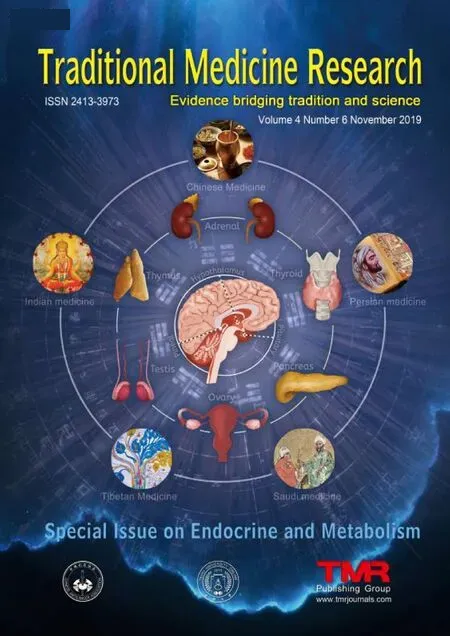The research of acupuncture on the treatment of alcohol dependence: hope and challenge
2019-01-14XueYang
Xue Yang*
1Department of Medical Oncology,Tianjin Medical University General Hospital,Tianjin,300052,China.
Acupuncture,a well-known form of alternative therapy,has been used for treating various disorders including pain,certain drug addiction,and withdrawal syndromes[1-5].Although there is not any histological or physiological evidence of traditional Chinese medical concepts such as Qi,meridians and acupoints,there is clear scientific evidence that acupuncture relates to endogenous opioid peptides release,and acupuncture can increase the activity of dopaminergic neuron in mesolimbic brain region through the endogenous opioid peptides [6-8].Till today,there is no convincing evidence to illustrate the nature of acupoints and also no clear mechanism explaining how the signals transport to the central nervous system from the special acupoints.However,recent research have found that the afferent impulses induced by acupuncture can be transmitted by Aβ and AΔ fibers [9,10],which sent the itch and tactile sensation to the brain; then the signals activate spinal cord,midbrain and pituitary-hypothalamus,which lead to the release of three endorphins and other monoamines[11-13].These results suggest that acupuncture can indeed activate neurons in the brain to perform physiological functions.
A new research from College of Korean Medicine,Daegu Haany University of South Korea sheds new light on the mechanics of acupuncture for the treatment of alcohol addiction.Researchers found that acupuncture at Shenmen (HT 7) point attenuated ethanol withdrawal tremor,anxiety-like behaviors,and ethanol self-administration in ethanol-dependent rats[14].During ethanol withdraw,the rats showed a decreased-endorphin level and a reduction of neuronal activity in the arcuate nucleus (ARC); they found that Shenmen (HT 7) acupuncture could increase the βendorphin level in the nucleus accumbens (NAc) and the c-Fos expression in the ARC,also could activate ARC neurons,then projected to the NAc and activated opioid receptors on accumbal γ-aminobutyric acid neurons.Meanwhile,the increased β-endorphin could significantly increase tyrosine hydroxylase phosphorylation in the ventral tegmental area,by which reversing the hypodopaminergic state during ethanol withdrawal.
This research provides a novel,potential treatment strategy for alcohol use disorder; meanwhile,also provides a new way to investigate the therapeutic effects and mechanism of acupuncture.Although the results of this study are positive,there are some confusions requiring further explanation.At first,in the study,only acupuncture at Shenmen (HT 7) point,but not at Yangxi(LI 5) point significantly attenuated behavioral manifestation.The author tried to explain the phenomenon by signal conduction of ulnar nerve,which lies adjacent to Shenmen (HT 7) point; But why not choice Neiguan (PC 6),Tongli (HT 5),LingDao (HT 4)pointset al,which are more adjacent than Yangxi (LI 5)point to ulnar nerve? One more thing,The function of acupuncture often base on the combinations of multipoints,the effects of Shenmen (HT 7) point combined with other points maybe provide some interesting results; how could the combined acupoints in diffident area function and how does spinal center signals affect hypothalamus deserve further researches.What’s more,the increased level of β-endorphin after Shenmen (HT 7)acupuncture was alcohol dependent,while the level of β-endorphin did not change under normal circumstances[14].These results could not explain the related endogenous opioid peptides release after acupuncture in the treatment of pain,certain drug addiction,angina pectoris,and so on.In the study,the increased βendorphin level after Shenmen (HT 7) acupuncture only presented within 30 mins,the short time β-endorphin increase seems unlikely to have much effects.Moreover,except β-endorphin,are there other molecules that also change after acupuncture at Shenmen (HT 7) points?The effects of acupuncture treatment also vary for different duration,frequency,making it difficult to assess the key characteristics that may be associated with the effectiveness of the intervention.At last,this therapy had so far only been tried out on mice,the sample size was also relatively small [14].What will happen for humans,as the pathways that control nervous & mental system in people are far more complex than they are in mice.
For the acupuncture treatment,what we can't ignore is that,the efficacy of acupuncture in the clinical treatment of alcohol diseases in different studies were inconsistent.Some clinical researches including metaanalysis with large sample size got the positive conclusion that acupuncture was effective for treating alcohol dependence such as alcohol craving,completion rates,and withdrawal symptoms as well as other drugs addition.However,contrary to the positive conclusion,some research found acupuncture did not show significantly difference with sham acupuncture (placebo acupuncture) [15-19].There is a long way to go in terms of both basic research and clinical studies.
杂志排行
Traditional Medicine Research的其它文章
- Study on the relationship between the structure of bacterial flora on the tongue and types of tongue coating in patients with type 2 diabetes mellitus
- A systematical review of traditional Ayurvedic and morden medical perspectives on Ghrita(clarified butter):a boon or bane
- Effects of Siwei Yuganzi decoction on LXRα and CYP7A1 in hyperlipidemic rats
- Effectiveness of health coaching on diabetic patients: A systematic review and metaanalysis
- Treatment of diabetic foot ulcer with medicinal leech therapy and honey curcumin dressing:a case report
- Tu Youyou:A scientist moving forward in controversy
